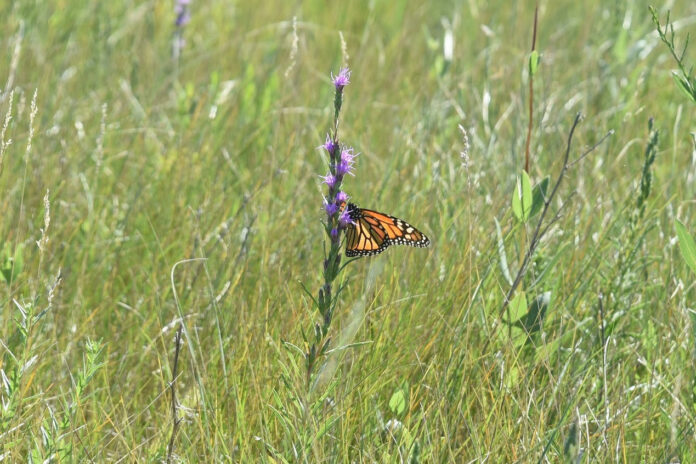AMES, IA — Adult monarch butterflies covered approximately 2.2 acres of forest canopy in Mexico, an area about three acres smaller than last year, according to the 2023-2024 overwintering monarch population report released by the World Wildlife Fund-Telcel Foundation Alliance, in collaboration with the Comisión Nacional de Áreas Naturales Protegidas, the Universidad Nacional Autónoma de México and the Monarch Butterfly Biosphere Reserve.
Forest canopy surveys have been conducted since the 1990s, and scientists estimate a long-term average of 15 acres of occupied forest canopy is needed to sustain the eastern North America monarch population. However, loss of breeding habitat in the United States and Canada, forest degradation in Mexico and extreme weather events have contributed to population declines over the last 25 years. A drought in the southern U.S. during the 2023 fall migration may have been particularly hard on monarchs this year, according to founding director of Monarch Watch Chip Taylor.
The winter surveys provide critical data to assess status and trends of the North American eastern monarch population and inform conservation practices in Mexico, Canada and the United States. The goal to maintain a long-term average of 15 acres of occupied forest canopy during the winter shapes objectives for establishing breeding habitat in the Midwestern states, including Iowa through the Iowa Monarch Conservation Consortium.
In 2020, the United States Fish & Wildlife Service (FWS) concluded that adding the monarch butterfly to the list of threatened and endangered species is warranted but currently precluded by work on higher-priority listing actions. The FWS is currently re-evaluating the monarch’s status under the Endangered Species Act, with a decision expected in September 2024. At this time, the FWS recommends continued implementation of voluntary conservation efforts within the upper Midwest.
The current Iowa Monarch Conservation Strategy — developed by the Iowa Monarch Conservation Consortium — guides the implementation and documentation of voluntary, statewide conservation efforts based on the best available science. This approach fosters habitat improvements in rural landscapes that do not conflict with agricultural production, are sufficient in scale to support improved monarch breeding success and strive to complement other conservation programs. The consortium is a group of 50 organizations, including agricultural and conservation associations, agribusiness and utility companies, universities and federal agencies.
“Iowans working together on public and private land are instrumental to improving monarch populations in North America,” said DNR Director Kayla Lyon. “The recent winter survey numbers show our work is not yet done; these habitat and conservation strategies can help us all make a difference for the next monarch breeding season.”
All Iowans can help support the monarch butterfly by planting milkweed and other flowering plants in their gardens, yards and even road ditches. To encourage habitat establishment, consortium members have collaborated with Iowa State University Extension and Outreach to develop a Habitat How-To webpage that provides practical steps and additional resources to guide planning and planting efforts. These resources include the free publications, “5 Ways to Help the Monarchs,” “Enhancing Monarch Butterfly Conservation in Iowa,” and “Monarch Seed Mix.”
“As we accelerate the pace of conservation and water quality practice adoption in Iowa, we are also looking for more ways to layer in habitat for wildlife, including monarchs and other vitally important pollinators,” said Iowa Secretary of Agriculture Mike Naig. “We continue to set records for conservation adoption in Iowa, but there is still much more work to do in the years and decades ahead. We are collaborating with public and private partners, including the Iowa Monarch Conservation Consortium, to expand pollinator habitat statewide while also improving soil health and water quality within our communities.”
To learn more about the Iowa Monarch Conservation Consortium and the resources it provides, visit iowamonarchs.info and follow @IowaMonarchs on Facebook, X and YouTube.
“Collaborative research at Iowa State with its many external partners continually helps us improve our understanding of where and how to implement conservation efforts to best support monarchs and our agricultural landscapes,” said Daniel J. Robison, holder of the Endowed Dean’s Chair in the College of Agriculture and Life Sciences at Iowa State. “The eastern population of the monarch butterfly continues to face serious challenges that the Iowa Monarch Conservation Consortium is helping address with effective partnerships and science-based information.”

































